Ballycarty Castle, Co.Kerry
Ballycarty,
or Ballycarthy,
just E of
Ballyseedy,
SE of
Tralee, Co.Kerry.
Ballycarty is at the
junction of the
River Lee (running E to W)
and what is (remarkably) an unnamed tributary coming in from the S.
Ballycarty is on the
SW side of the river junction.
The old Ballycarty Castle
was a Geraldine
(Desmond
branch) fortress,
perhaps 15th century.
It was
confiscated after the
Desmond rebellion was defeated in 1583.
Blennerhassett at Ballycarty Castle
Ballycarty Castle was granted to
Thomas Blennerhassett
of Flimby, Cumberland, in 1590.
Thomas and his son
Robert Blennerhassett
came to Ireland.
Thomas returned to England,
but Robert stayed in Ireland, and lived at Ballycarty Castle.
See the mysterious
1627 arms
now at New Ballyseedy.
The 1641 rebellion
started in Oct 1641.
At this time,
Robert Blennerhassett and his son
John Blennerhassett
were both living at Ballycarty.
They
surrendered Ballycarty Castle to the rebels in Nov 1642.
Blennerhassett seat moves to Ballyseedy Castle
After the wars of 1641-1653,
Ballyseedy Castle
became the main seat of the Blennerhassett family.
But Blennerhassetts continued to live at
Ballycarty.
Agnes Blennerhassett
was born at Ballycarty in 1740.
[Houses of Kerry]
thought
Ballycarty Castle was at the same site as
Ballycarty House, and replaced by it in 1765-1770.
However, the old Ballycarty Castle
seems to be the ruin that survives today to the NE of Ballycarty House.
Ballycarty House
The new
Ballycarty House
was built in 1765-1770 period some distance SW of the river junction.
It was built
by the Nash family
(not connected to Blennerhassett).
Ballycarty House was burnt by the Republicans in the
Civil War
in January 1923.
It was a ruin for many years.
The ruins were mostly cleared when a
new Ballycarty House was built at the site in 2009,
though it does incorporate
some of the 18th century structure.

Ballycarty (marked in yellow)
on a 1587 map.
Printed in
Hickson's Kerry Topography.
N is down, so Ballycarty appears at the top right of the junction of the rivers.
And Tralee to the W appears to the right here.
If N is up, we see that Ballycarty is SW of the junction of the rivers.
See
original
and
wider.

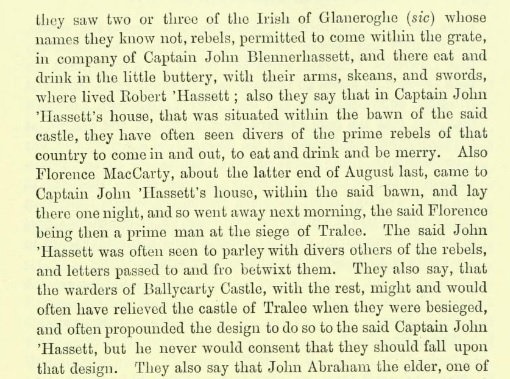
A deposition of 1643 about the events of the 1641 rebellion.
This shows both
Robert Blennerhassett and his son
John Blennerhassett living in two different households at Ballycarty Castle.
They were accused of fraternising with the rebels at Ballycarty Castle.
From
pp.122-123
of [Hickson, 1884, vol.2].
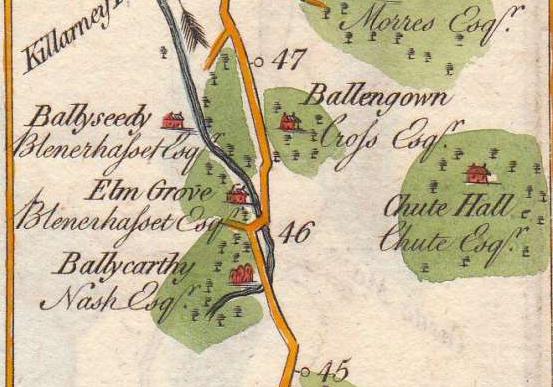
Ballyseedy and Ballycarty on
1777 map.
Up is W.
Orange is the old coach road.
Note that the old coach road runs S of the river
between Ballyseedy Bridge and the old bridge at Ballycarty.

[The Post-chaise Companion, 1786, p.186]
lists
"ruins of Ballycarthy castle"
at this location.

The old ruin at
Ballycarty (red cross) on
1829 to 1842 map.
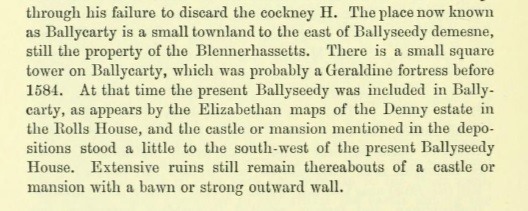
Extract from
p.124
of [Hickson, 1884, vol.2].
Hickson says that "a small square tower" at Ballycarty
would be the old castle.
So it looks like the ruin above.

Ballycarty on
1887 to 1913 map.
The old coach road is visible here running S of the river and across an old bridge.
It was replaced by the new road N of the river and a new bridge
(since replaced by a further bridge).
There is a ruin NE of Ballycarty House.
It is the building just E of the "Lodge",
on bank of River Lee,
near the old bridge over the river.
Bill Jehan
says it is close to
"an ancient and beautiful bridge that once carried the old coach road to Tralee".
See other copy.

Ballycarty on
modern map.
The ruin by the river
is marked "Castle (in ruins)" to the NE of Ballycarty House.
The large building to the NW is the
Earl of Desmond Hotel.
The ruin at Ballycarty
The following are pictures of the surviving
ruin near the river at Ballycarty,
on the S bank of the River Lee,
NE of Ballycarty House.
This is probably the old
Ballycarty Castle.
-
Bill Jehan
says this is
Ballycarty Watermill,
an old watermill for the Blennerhassett estate.
- But it is an odd building, with very thick walls (defensive)
and lots of windows (not defensive).
-
Bill Jehan says:
"The precise location of old Ballycarty Castle is uncertain. It may have been incorporated into the later Ballycarty House, but the parts of Ballycarty watermill, whose ruins survive close by on the bank of the River Lee, appear strong enough to have been defensive - if so perhaps the old castle was adapted to become the mill."
-
excavations.ie
looked at this building and
dates it to the 1600-1750 period.
It says:
"It would appear that the current edifice was an earlier 17th-century defended structure
that was added or remodelled in the post-Cromwellian period."
-
So it may be the old Ballycarty castle put to work for other uses
after Blennerhassett moved to Ballyseedy.
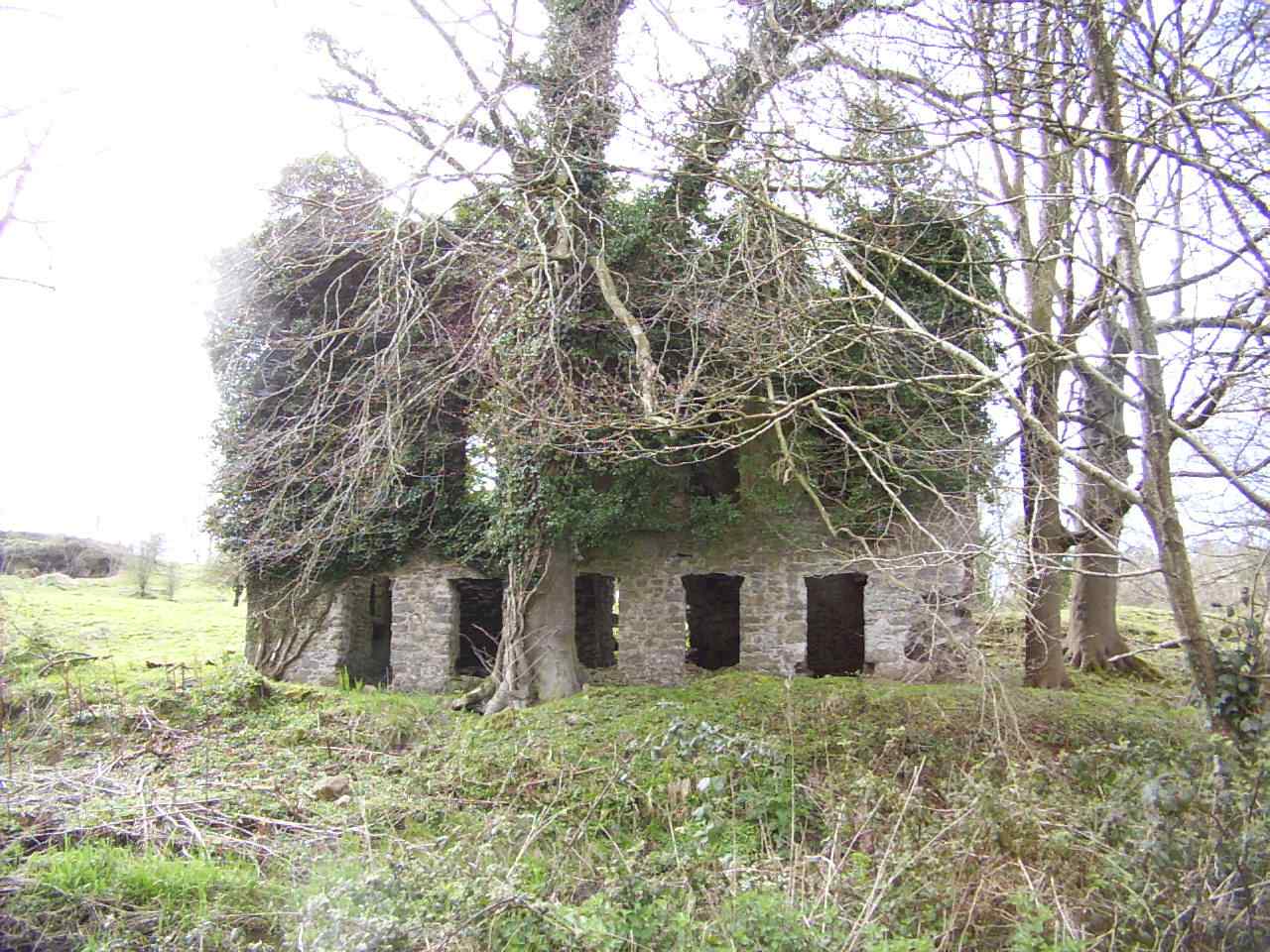
The ruin at Ballycarty.
See
larger
and
original.
See
other shot.
This and other photos 2004 by
Bill Jehan.
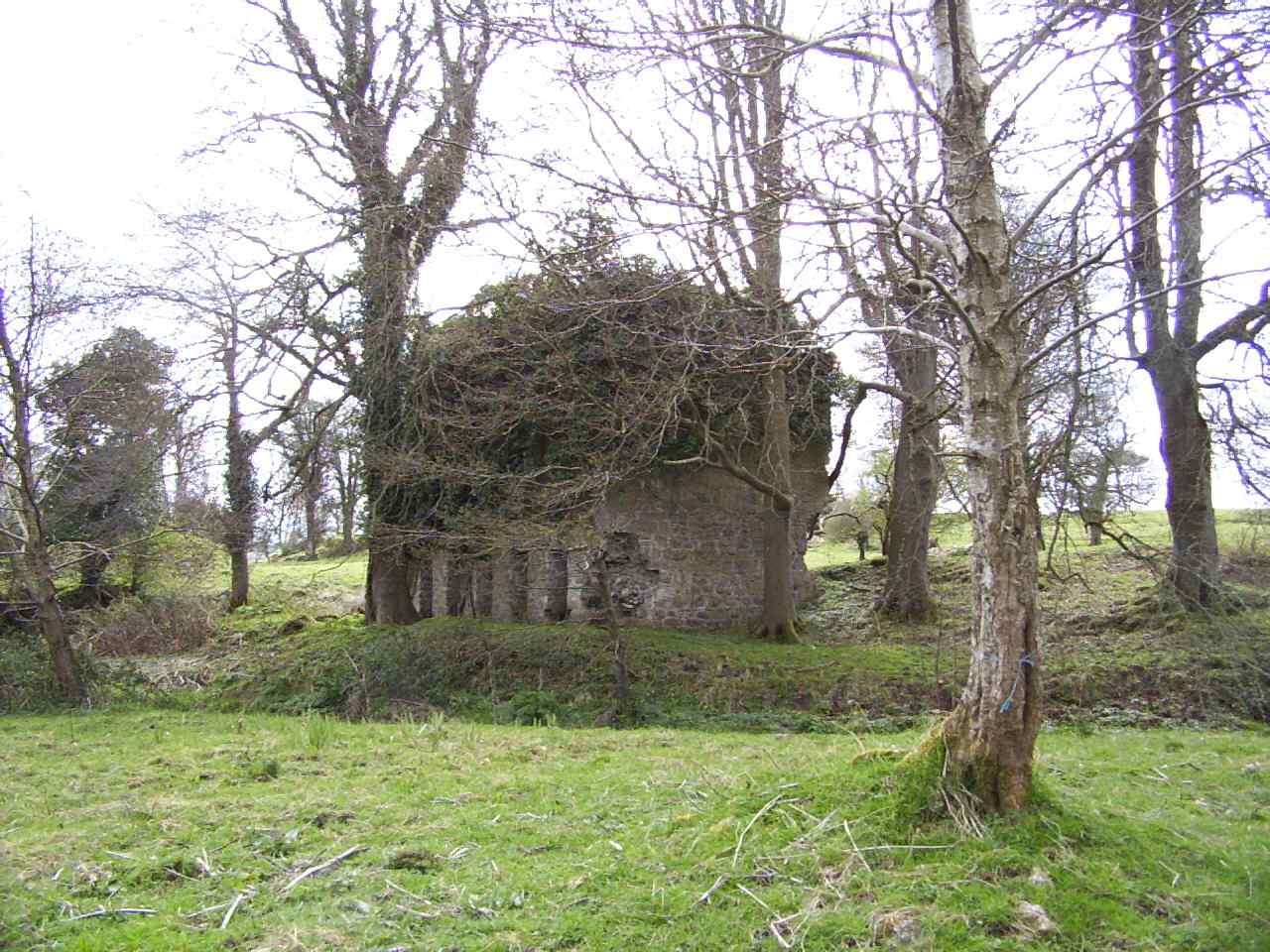
The ruin at Ballycarty.
See larger
and original.
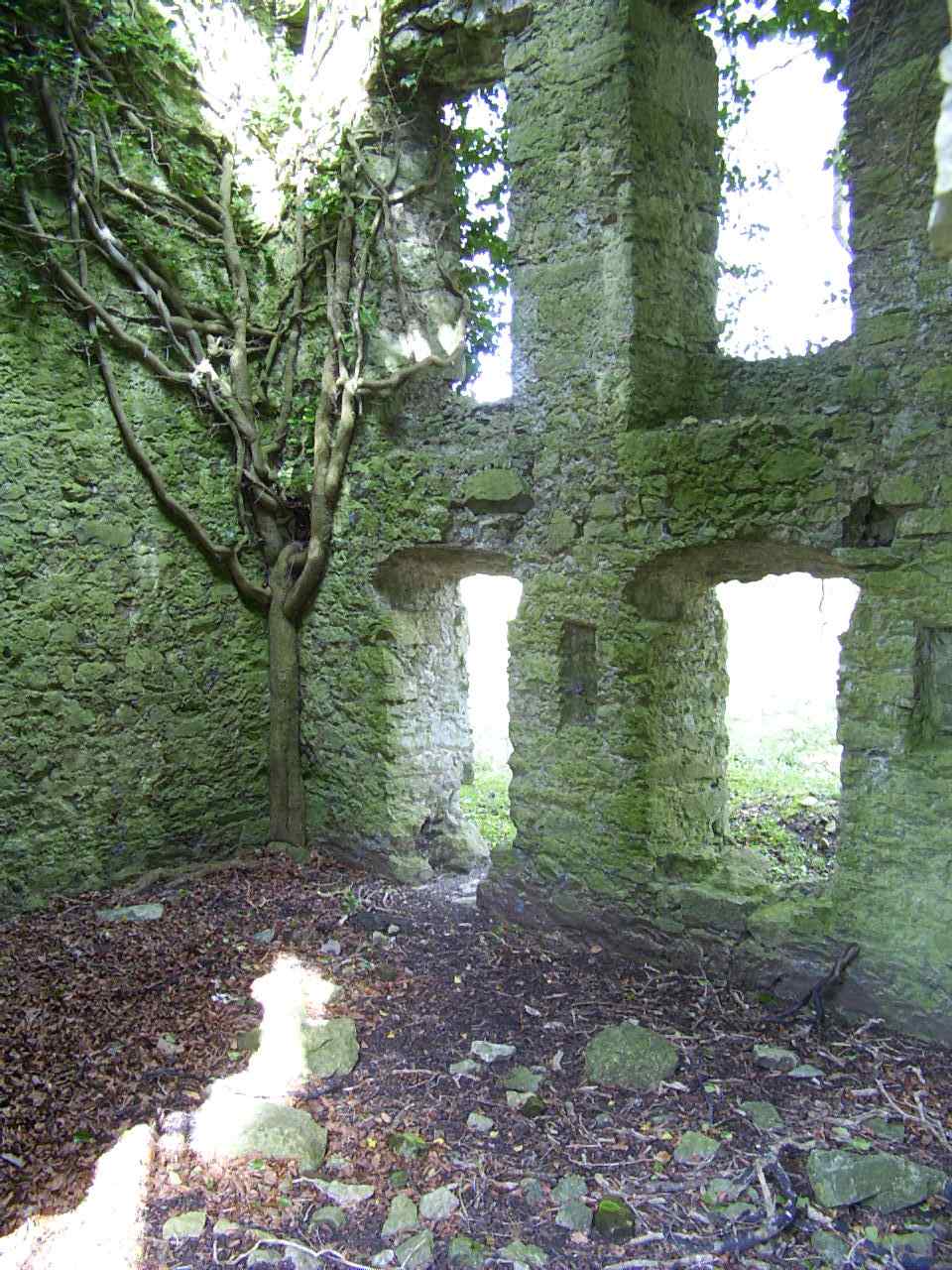
Interior. The ruin at Ballycarty.
See larger
and original.
There is a coat of arms with the date "1627"
at
New Ballyseedy.
It is near the door of the library.
This is now the bar of the hotel.
It is in the
wainscot
or wooden panelling around the walls.
The hotel says this carving is 19th century.
Bill Jehan
is inclined to that view.
Oddly, 1627 does not fit well into the family history
and it is unclear what the date refers to.
What can 1627 mean?
-
The date when Old Ballyseedy was built?
But in the 1641 war, Blennerhassett is still living at Ballycarty.
Old Ballyseedy must be built later.
-
So 1627 would seem to be a date from the Ballycarty period.
But what?
-
Could 1627 be the building of a second house at Ballycarty Castle
to accomodate the multiple generations of Blennerhassetts now living there?
-
And is it a real date from the time, or just a date someone in the 19th century thought made sense?
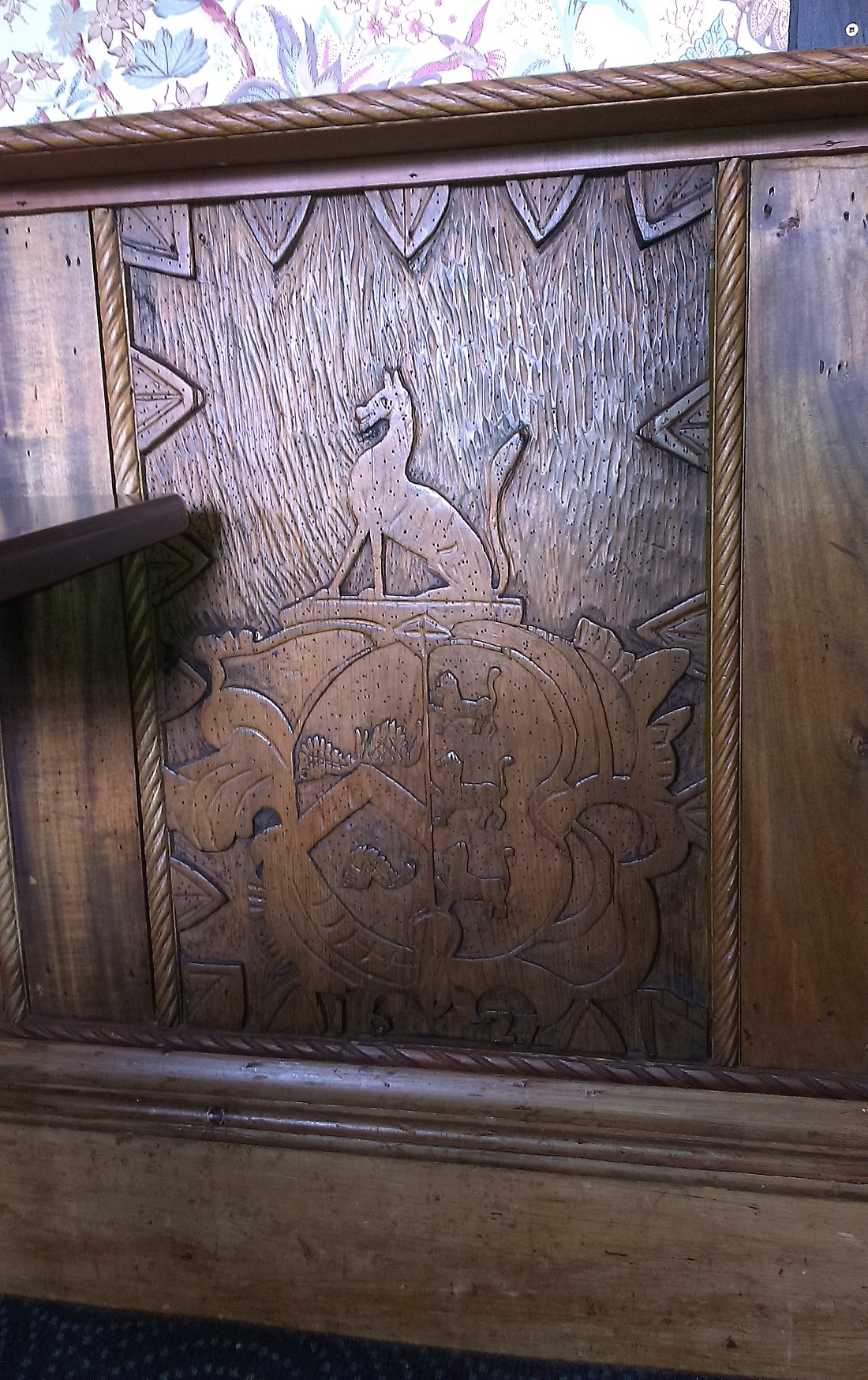
The coat of arms with the date "1627".
Photo 2016.
See
larger
and
full size.
See
other shot.
See
other shot.
Photo apparently 2006. From
Bill Jehan.
See
wider shot.
Photo 2000.
-
The Blennerhassett arms (on LHS)
seem to be combined with another family's arms.
Could 1627 refer to a marriage?
-
The obvious choice would be the marriage of
Blennerhassett and Lynne.
However
1627 seems a little late for their marriage.
Bill Jehan
notes the arms do not match the arms of Lynne.
They look simply like the
Royal Arms of England.
- In conclusion, the whole carving is a mystery and may contain 19th century errors.
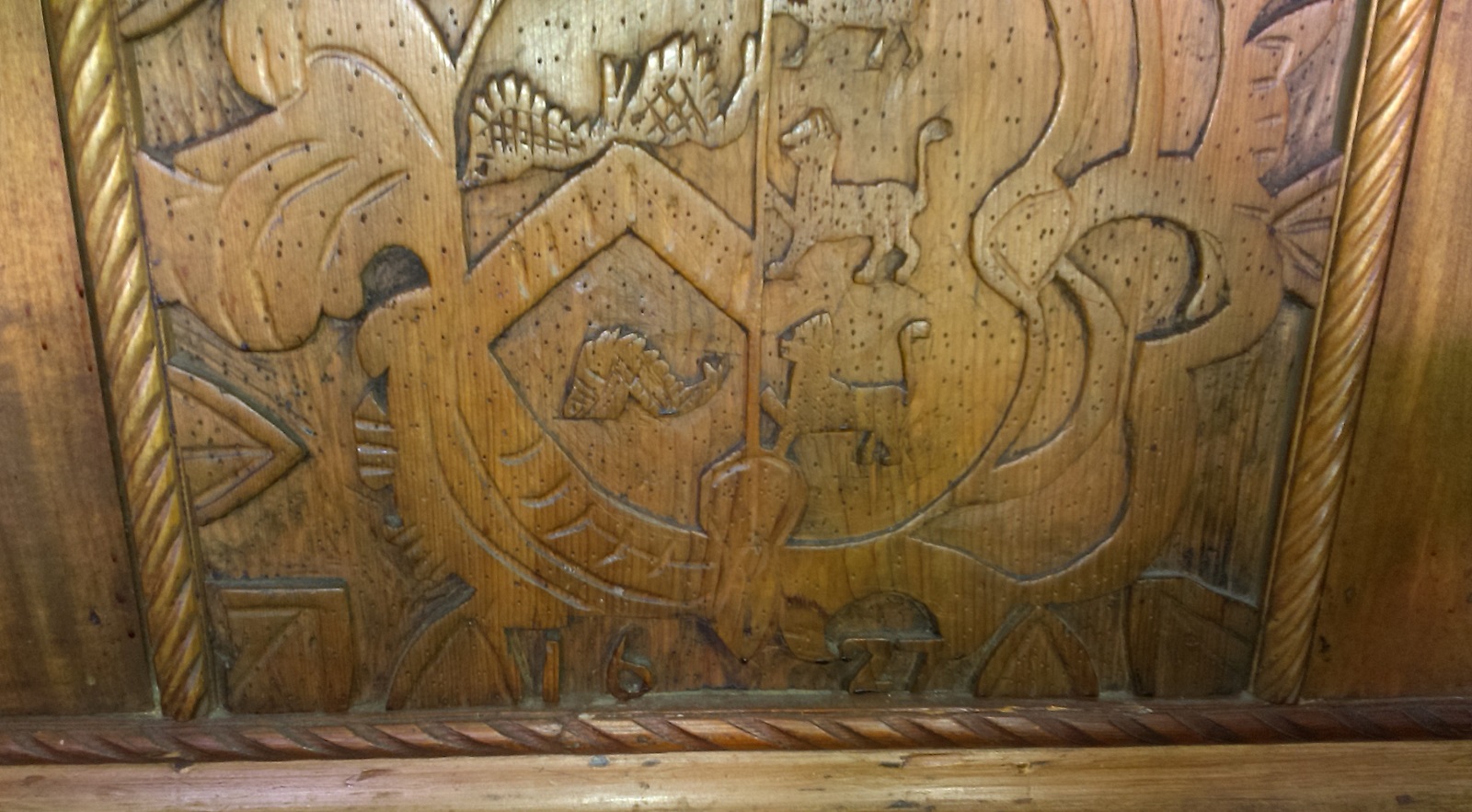
Close-up of the coat of arms with the date "1627".
Photo 2016.
See
larger
and
full size.
See
other shot.
Ballycarty House

Ballycarty House.
From
Bill Jehan.
Photo from Antonia Johnson.

Ballycarty House.
See larger
and original.
See other shot
and other shot.
Photos 2004 by
Bill Jehan.















